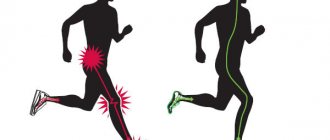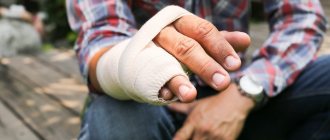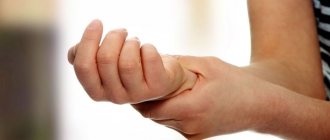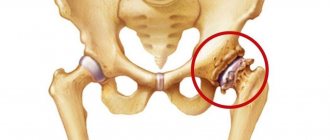The largest joint in the human body is the hip joint, which is where the pelvis meets the femur and is made up of a variety of bones, tissues, and other structures.
Functions of this joint: providing rotational, flexion-extension movements. Also, a healthy hip joint supports the weight of the entire body and ensures a person’s upright posture.
Signs of hip diseases are:
- pain,
- deterioration of mobility in this area,
- swelling in the joint area,
- redness and increased local temperature (with inflammation),
- difficulty moving (due to destruction of cartilage or bone tissue),
- shooting and “jerking” pains,
- heat,
- swelling and redness with purulent lesions of joint tissue.
The most common diseases of the hip joint include:
- Coxarthrosis (arthrosis) is a metabolic disorder in articular cartilage, leading to its degeneration.
- Arthritis (coxitis) – inflammation in the hip joint.
- Bursitis is an inflammation in the synovial bursa of a joint, the purpose of which is to prevent friction.
- Hip dislocation is a displacement of the head of the femur, which is accompanied by damage to the joint capsule.
- Dysplasia is underdevelopment of bone tissue.
- Tendonitis is inflammation of the tendons in the area of the joint with the hip bones.
- Osteosclerosis is damage to areas of bone due to compaction of bone tissue.
- Osteoporosis is a decrease in bone density due to leaching of calcium and phosphorus.
- Perthes disease (aseptic necrosis) is a non-infectious destruction of the head of the hip bone.
In medicine, the following causes of pain in the hip joint are identified:
- inflammation (infectious arthritis),
- autoimmune damage (rheumatoid and reactive arthritis),
- violation of tissue integrity,
- joint injury in athletes or elderly people,
- endocrine changes in adolescents and children,
- metabolic disease,
- coxarthrosis,
- destruction of joint joints,
- fractures, dislocations,
- necrosis and other diseases of the hip joint, as well as congenital anomalies of the hip joint.
Psychosomatics of the hip joint
A joint is a moving part that is flexible. Let us also remember that this flexibility allows the joint to rotate and bend the leg, and turn the leg to the right and left sides. Transferring these functions of the joint into psychological language gives us a hint about the subtle meaning of the hip joint, of which it is a symbol for a person.
- Louise Hay claims that joints symbolize changes in directions in life, ease of movement in a person’s life.
- Psychologist Liz Burbo writes that when walking, the movement of the leg begins from the hip joint, so problems in this joint indicate that a person cannot start moving (thoughts like “nothing will work out”).
- Dr. V. Sinelnikov, based on his practice, claims that joints are responsible for the expression of negative emotions such as irritation, anger, anger. If a person suppresses them in himself and does not allow them to manifest themselves, then the joints become ill.
But what area of life is associated with negative emotions and loss of flexibility that lead to hip ailments?
First, let's remember what the pelvis and thigh symbolize (it is these bones that are connected by the hip joint that interests us). The pelvis is the lower support, the house in which a person finds support, the thigh is what maintains balance (Louise Hay).
Other authors on psychosomatics give additional symbols of the hip: success, leadership, power. They reveal the metaphysical symbolism of the human thigh through such qualities as vital stability, the ability to fight, the ability to defend one’s principles, endurance, and the ability to protect.
It turns out that a person “hardens” in thoughts and beliefs related to his life support (home, family, work, relationships with family and friends, some basic principles). Due to negative thoughts and emotions about his support in life, he begins to lose his peace of mind.
But how to move forward in life if you lose your support and balance? Barely or not at all – our body signals to us.
How are mental pain and physical pain related? We get the answer by considering the mechanism of action of negative thoughts and emotions on the physical body.
Thus, an important component of joint fluid is hyaluronic acid. But the production of this acid is inhibited by the so-called corticosteroid hormones, which are released in excess into the blood during prolonged stress and emotional tension. Articular cartilage begins to dry out, crack and become thinner.
These same “stress hormones” impair blood flow in the joints, which also negatively affects the condition of the joint.
Stress also has a negative impact on muscle function. In our case, due to spasms resulting from stress, the periarticular muscles begin to tighten the joint. This also leads to disruption of the joint and its deformation.
Psychosomatics of arthrosis of the hip joint and its healing using the methods of Spiritual Integration.
Methods of Spiritual Integration are gaining more and more popularity among progressive individuals. And this is not surprising, because when a person turns to Spiritual Integration in an attempt to find a way out of a hopeless situation, or to cure an illness that has been tormenting him for decades, and as a result he receives a radical improvement in life in general.
In this author’s system of a successful, progressive psychologist of our time, candidate of psychological sciences, Konstantin Dovlatov, there is an opportunity for everyone in the shortest possible time, using the strength of their soul, to determine for themselves the hidden sources of diseases and problems.
And as a result, get rid of problems, failures, diseases, including psychosomatic diseases of arthrosis of the hip joint.
The name of the system explains that the work to gain one’s own integrity occurs at the level of subtle, spiritual planes.
Developing the skills and fundamentals of this system is available to everyone.
One of the unique techniques in Spiritual Integration is reintegration , which allows you to clarify and clarify various obstacles that hinder positive metamorphoses in the life of a student,
Master reintegration techniques,
Nowadays, you can study the basic basis of Spiritual Integration both through live training and through online training.
Psychosomatics of pain in the hip joint
Famous author on psychosomatics Liz Burbo notes that the beginning of leg movement depends on the hip bones, so pain in this area indicates that a person cannot decide to take some step (changing jobs, forgiving a loved one, etc.)
As psychologists explain, the occurrence of pain in the hip joint when a person stands signals that he wants to move, but fears are holding him back. Increased pain in a sitting position is typical when a person does not give himself a break.
In psychosomatics, it is also customary to pay attention to which side the illness manifested itself, as this provides an additional clue. Thus, pain associated with the right thigh clearly indicates that the person does not have satisfaction from the tasks completed, but there is an attempt to prove his importance, and there is also a suppression of his feelings.
Pain associated with the left hip indicates fear of the future, fear of making decisions, as well as rigidity and lack of flexibility.
Liz Burbo believes that joint ailments are associated with indecision, self-doubt, fatigue and reluctance to act. Moreover, the more pessimistic a person is, the stronger the pain in the joint.
It was also found that pain and inflexibility of the hip joint indicate that patients adhere to strict rules and strong views in their lives, and also like to control.
Causes of psychosomatics of the hip joints. Expert opinion.
The famous psychosomatics researcher Liz Burbo in her treatise “Your Body Says: “Love Yourself”” states that the occurrence of these diseases is facilitated by the fact that the patient cannot decide to make some kind of movement (change jobs, forgive a loved one, etc.)
The author also believes that joint diseases are associated with the patient’s indecision, lack of self-confidence, fatigue and reluctance to act.
And, the stronger the pain in the joint, the more pessimistic the victim is.
In the metaphysics of diseases, it is important to pay attention to the side on which the disease manifested itself.
This gives additional clues. Thus, the right hip joint, the psychosomatics of the disease, directly indicates competition at work and the fact that the victim does not receive satisfaction from the work performed. He tries to prove his worth and importance while holding back his feelings.
If you have problems with the hip joint, we recommend attending the free webinar by Konstantin Dovlatov “How to turn life’s crises into resources.”
Any problem or illness contains a lot of value for us if we know how to extract it.
Problems of the left hip indicate fear of the future, fear of making decisions, the desire to prove one’s success to family, relatives, friends, as well as rigidity and lack of plasticity.
But the Estonian doctor, parapsychologist Luule Viilma explains the problems of the hip joints in psychosomatics, with such emotions and mental trauma (see table):
| Ailments | Mental trauma | Book | Page no. |
| Hip problems | Problems of economic and material life. | "Warmth of Hope" | 171 |
| Foot problems and diseases | Secrecy in communication related to material and financial issues. The desire to receive material benefits, honors and praise in everything. | “Pain in your heart” “No harm to yourself” | 205-214 92 |
| Hip pain | Feeling of responsibility. Shyness | “Forgiveness, real and imaginary” | 211 |
Louise Hay, popular all over the world, author of the bestseller “Heal Yourself,” explains that psychosomatics of the hip joint has the following sources (see table):
| Disease | Possible reasons | Positive Affirmations |
| Upper thighs | A stable base for the body. Basic design when moving forward. | Long live the hips. Every day I am filled with joy. I am free and I stand firmly on my feet. |
| Hips: diseases | Fear of moving forward in implementing major decisions. Lack of goals. | My resilience is unshakable. I move forward through life with ease and joy at any age. |
| Right side of the body | Concession, refusal, male energy, men, father. | I easily and effortlessly balance my masculine energy. |
Dr. R.G. Hamer, author of New German Medicine, confirmed the connection between disease and mental trauma using the biological laws of the root causes of disease.
He explains the occurrence of psychosomatics of arthrosis of the hip joint by a slight conflict of self-depreciation associated with the location of the damaged joint.
The main experience that leads the patient to pathology is: “Something will not work out for me, or for a person close to me. I feel anxious that I won’t be able to.” The victim may or may not be aware of such a thought. But if the patient is worried about whether he will succeed, pathologies begin to arise in the cartilage tissue of the joint.
When the patient manages to resolve the formative conflict, the healing stage begins.
Psychological causes of hip diseases
So, joints contain the force of dynamic tension - the ability to move. And they immobilize the body when life’s movements and actions bring suffering instead of joy (despair from having to work without joy, constant tension due to the thoughts “I can’t keep up”).
Let's take a closer look at the causes of some psychosomatic ailments of the hip joint.
Louise Hay names the following psychological causes of arthritis: the understanding that you have never loved, criticism, contempt. Liz Burbo writes that a person suffering from this disease is usually too strict with himself; he experiences anger and malice towards himself.
Arthritis can also indicate a fear of new things, a reluctance to change the principles of life, and adapt to the situation.
The psychological portrait of patients suffering from arthrosis is interesting. Outwardly they are friendly and calm people, but inside they have suppressed negative emotions. Thus, they destroy themselves through anger, malice, and a sense of injustice.
For clarity, I will give an example from life.
Example from life
Example from life
I was lucky enough to be a roommate of an elderly woman who suffered from arthrosis.
She was a sweet, friendly and kind old lady. From her story about herself, it became clear why she developed this illness, and even a progressive one (that is, the treatments practically did not help, they were simply blocked for a while). She worked all her life as a teacher (a profession that requires suppressing her emotions, which cannot be shown). When I was young, I was left without a husband with one daughter (I had to pull myself together to move on with my life). The daughter grew up, moved far away, got married there and stayed. From then until now, this woman has been alone (she is somewhere around 80), there are almost no relatives left, so there was no one to visit her in the hospital. My daughter cannot come to visit because she is busy with business. To the question “Why don’t you go and live with your daughter?”, she answered: “Yes, she has been wanting to take me to her place for a long time. But I feel good here, I live freely, in my own way, and sometimes I meet with friends. And there I will have to live by different rules (note: that is, change something in my life, adapt to the situation). Sit in the room assigned to me and look out the window. I do not want it". On the one hand, it is easy to understand. But, on the other hand, you can make friends there too, and not only sit in the room, but continue to live actively (if you want).
The resentment and anger that a person experiences because of the current situation destroys the joints. But the person chooses the outcome of the situation himself and receives the corresponding consequence.
The psychosomatics of arthrosis, as it turned out, is also associated with workaholism, based on a lack of understanding of the meaning of one’s life. In this case, the person is used to working constantly to fill the inner emptiness. At the same time, the patient is stubborn and inflexible.
arthrosis of the hip joint with the fact that a person lives in a constant race for success, in competition and competition mode. At the same time, an ailment of the left joint indicates that a person seeks to prove his success to his family, relatives, and friends. A sore right joint indicates competition at work.
Osteosclerosis is based on a reluctance to perform an action, a lack of flexibility. People suffering from this disease tend to be uncompromising. On the other hand, the inability to refuse, self-doubt and irritability can also cause osteosclerosis.
a dislocation of the hip joint when he is forced to go (literally and figuratively) where he does not want, while being angry with himself, which allows him to be manipulated by others.
Reiki specialists B. Baginski and Sh. Shalila note that dislocations occur when a person himself “twists” someone in life.
the cause of bruises of the hip joint as the fact that a person cannot decide to take some action.
Destructive changes in joints begin from prolonged disappointment from joyless work.
Inflexibility and stiffness of the hip joint are caused by fear of the future and inability to make decisions.
According to O. Torsunov, problems with joints are caused by such long-term negative human emotions as resentment, disappointment, despair, criticism (the habit of criticizing everyone and everything), assertiveness, idleness, passionate work (meaningless work, work for the sake of work).
Reached the point of illness: psychosomatics of pain in the legs
Finger diseases
Psychosomatics can describe the connection of each finger with emotions separately, but in general they are responsible for a person’s self-devaluation, his self-limitation due to fears or low assessment of his own activities.
Such a person necessarily thinks that he is awkward, that he cannot do something well (although, perhaps, he has not even tried). Also, finger injuries often indicate conflicts and problems with relatives. A bone on the thumb is a sign that the relationship with the mother is broken.
Hip diseases
Problems with the upper thigh mean loss of support, fears of moving forward.
Hips in general indicate a low degree of flexibility, accumulation of grievances, inability to release the desires of your inner child, enjoy life, and holding back your feelings and emotions.
Do not miss
- Do not miss
Fell, woke up, cast: 5 emotions that cause more frequent fractures
Knee diseases
Arthritis, arthrosis and other joint damage may be associated with a desire to compete. We often compete with our partner, wanting to be better than him.
Also, knee dysfunction is associated with low self-esteem and devaluation of oneself.
Diseases of the legs and calves
They also talk about great fears of moving forward, as well as the need, but unwillingness, to do something to achieve the goal.
Sometimes, on the contrary, a person does not give himself the opportunity to stop moving, to prepare normally for changes, he wants to do everything at once.
Do not miss
- Do not miss
4 exercises that will reduce leg discomfort after sedentary work
Foot diseases
Their reason is a lack of development due to fear or low self-esteem. Inability or unwillingness to turn life in the right direction, escape from reality. A person is afraid of being insulted, fired, left alone - in general, without support and support.
Swelling and bruising
Sometimes it seems that you didn’t even hit yourself, but a bruise suddenly appeared. It is believed that in this case we internally punish ourselves for something. This usually happens due to low self-esteem and a constant feeling of guilt before oneself and before others.
Swelling, as well as varicose veins and atherosclerosis, arise due to a lack of joy in life. According to psychosomatics, our joy flows through our vessels with energy. And if it’s not there, blood clots form. A person works in a job he doesn’t like, doesn’t have time to please himself with anything, doesn’t fulfill his dreams - all this leads to illness. Also, swelling speaks of something that we are afraid to part with, although it has already outlived its usefulness. And these are not only people, but also situations from the past, grievances that we still accumulate.





